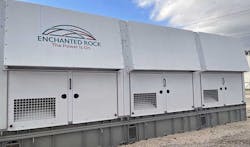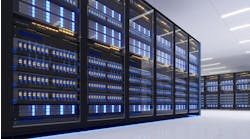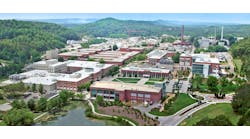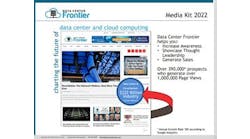Microsoft to Use Microgrid, Biofuel for Backup Power at New San Jose Data Center
Microsoft will use a microgrid at a new data center in San Jose, Calif., which will use renewable natural gas (RNG) instead of diesel fuel to power its emergency backup generators. The project advances Microsoft’s goal of moving off of diesel fuel in its data center operations by 2030.
“This project helps Microsoft take a step towards our goal of eliminating dependence on petroleum-based diesel, while increasing the resilience of our data center and providing a much-needed capacity resource to the local grid,” said Brian Janous, General Manager, DC Energy & Sustainability at Microsoft.
The San Jose project is also a big step forward in the use of microgrid technology in data centers. Microsoft is partnering with Enchanted Rock to develop the project, which will be California’s largest microgrid fully supported by renewable natural gas derived from agricultural waste rather than fossil fuels.
“Microsoft’s decision to pursue a renewable microgrid marks another milestone in the industry as businesses continue to move away from conventional, less carbon-friendly methods,” said Thomas McAndrew, CEO of Enchanted Rock, a leading provider of microgrids. “We expect this project will demonstrate that large-scale, reliable, and cost-effective back-up generation with net-zero carbon can become the new standard.”
Enchanted Rock announced the Microsoft project ahead of today’s morning keynote at the 7×24 Exchange Spring Conference in Orlando, which will focus on the use of microgrids in data centers.
The microgrid project is the latest addition to Microsoft’s strategy to make its backup power more sustainable. In July 2020 Microsoft said it will to eliminate its reliance on diesel fuel by the year 2030 as part of its goal to be carbon negative. Since then, it has successfully tested the use of hydrogen fuel cells to power data center servers in Salt Lake City, and also begun using low-carbon “eco-diesel” fuel based on tall oil in the generators at its new data center campus in Sweden.
How Microgrids Can Support Data Centers
Microgrids provide access to multiple energy sources – the utility grid, energy storage, generators, solar or wind energy – and can allow data centers can operate independently of the grid during outages and times of crisis. Microgrids offer the potential to add new generation sources for primary or backup power, with a controller that manages the different energy sources.
DCF noted the potential for microgrid development in our 2022 forecast: “Microgrids are shaping up as a key enabler of on-site generation and energy diversification. Data center microgrids can also integrate renewable energy sources, which can reduce carbon emissions.”
Renewable natural gas, also known as RNG or biomethane, is a low-carbon natural gas alternative that is a mixture of carbon dioxide and hydrocarbons, primarily methane gas. It is captured when organic waste decomposes and releases biogas. Sources include landfills, livestock operations, wastewater treatment, and organic industrial waste. The biogas is collected and purified, creating a pipeline-quality gas that is interchangeable with conventional natural gas.
Enchanted Rock has been providing “resiliency as a service” offerings since 2006, including a microgrid software platform to monitor and optimize its systems. The company supporta hundreds of clients in healthcare, water pumping stations, military bases and grocery stores.
“These are all industries that consider themselves mission-critical to their communities,” said Allan Shurr, Chief Commercial Officer at Enchanted Rock.
The San Jose project will be the second microgrid that Enchanted Rock has deployed for a data center client, with the first being a government client. The Microsoft deployment will be considerably larger, as regulatory filings indicate a future campus capacity of up to 99 megawatts at full buildout.
Microsoft’s Sustainability-Focused Innovation
The Microsoft data center is being built on land in North San Jose that the company acquired in 2017. It will be part of a global buildout of the Azure cloud platform, which CEO Satya Nadella described as “the world’s computer to support organizations’ growing cloud needs.”
As its global cloud expansion has gained pace, Microsoft has accelerated research on optimizing its data centers for efficiency and sustainability. This initiative has included projects to immerse servers in cooling fluid, slash water usage by running warmer data halls, and even build data centers from mushrooms and algae.
It has also done research into alternative energy sources for data centers. In 2014, Microsoft outlined plans to power portions of its facility in Cheyenne, Wyoming with biogas waste from a water treatment plant. In 2017, the company created an Advanced Energy Lab in Seattle that powered 20 racks of servers with fuel cells powered by natural gas.
Given that backdrop, it’s not surprising that Microsoft is seeking to pioneer the use of microgrids and biofuels. Enchanted Rock says the San Jose project will outperform current California Air Resources Board’s stringent emissions requirements for distributed generation, with hourly local emissions 80 to 90 percent lower than Tier 4 diesel standards, while delivering higher reliability.
How It Will Work
Enchanted Rock will act as the service provider for Microsoft, providing the equipment, maintenance, fueling and grid services to support the backup power for the campus. That includes renewable natural gas generators to provide electrical power to support the data center uses during utility outages, as well as the fuel.
The renewable natural gas will be injected into the natural gas pipeline system upstream from the data center, replacing natural gas based on fossil fuels. The microgrid is scheduled to begin operations in 2024.
“We believe there will be ample supply (of RNG) to support this project,” said Schurr. “We have a robust supply chain and multiple providers that work for us.”
Enchanted Rock will also offer grid services, which could include running generators to offset load on the utility grid, or even to generate surplus power to sell to the grid operators.
The initiative was hailed by Dean Nelson, Chairman and Founder of Infrastructure Masons, who noted that both Microsoft and Enchanted Rock are part of the group’s Climate Accord to reduce data centers’ carbon impact.
“We applaud the work they are doing together to drive microgrid innovation at scale, reducing carbon intensity in electrical service without harming public health,” said Nelson.
California has been a geographic focal point for data center resiliency projects, given the innovation heritage in Silicon Valley and the the growing challenge of managing uptime through rolling blackouts on the state power grid in recent years. Equinix is using Bloom Energy fuel cells supported by natural gas as the primary power source for the newest data center on its campus in South San Jose.
“Today’s digital world relies on the uptime and continuity of data center operations,” said McAndrew. “This continuity does not need to come at the expense of companies’ carbon emission reduction goals or local air quality.”
The public health benefits of reducing diesel emissions were noted by advocates for stronger environmental policies in California.
“California needs practical alternatives to diesel backup generation in order to protect public health and prevent catastrophic climate change,” said Bill Magavern, policy director for the Coalition for Clean Air, a statewide organization that advocates for clean air policies. “This means deploying flexible, dispatchable solutions that can tackle the intermittent nature of renewables, while reducing the environmental and public health impacts of diesel-fueled generators”






